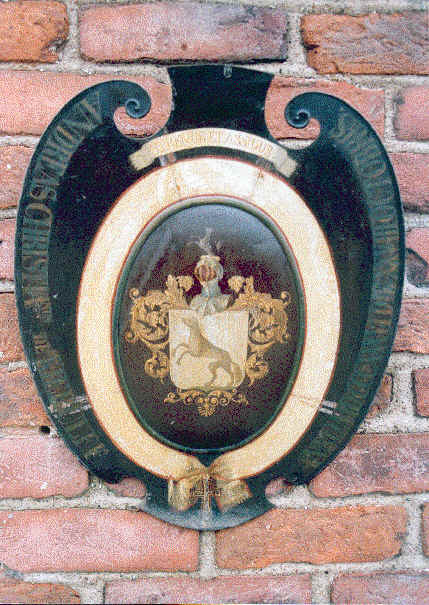
Kjærulf Crest and Coat-of-arms

Coat-of-arms of Andreas Christian de Kjerulff hanging in Frederiksborg Castle, Hillerød, Denmark photograped by Jes Kjerulff (see story below). The coat of arms is listed in the museeum as ”Kjerulf A. C. nr 792, Overpræsident i København 28 okt 1836”.
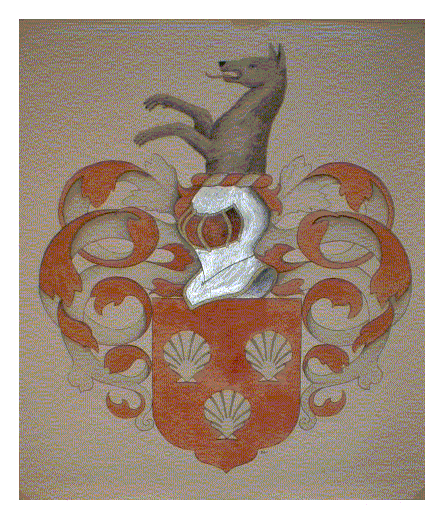
Reproduction by Erik Karoll of a Kjærulf coat-of-arms
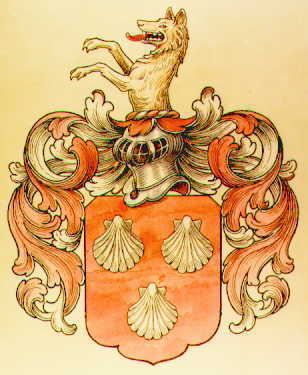
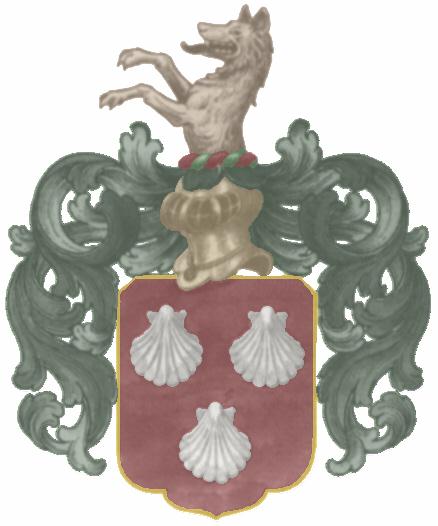
Family Crest on broken matelpiece at Vitskøl Cloister (click to enlarge)

Crest of Otto Richard Kierulf (Prime minister in Norway)

Jan Vicent Kierulf (TCK-81) from the Philippines has a tatoo of the family crest
After I printed & distributed our 1986 TCK-Book, several of our Danish
Cousins wrote to me & told me the following facts, and sent me copies
from magazines, about the centuries-old walking-trek "still" made by
Christian Pilgrims to a Saint's Cathedral in the very North-West-Tip of
Spain.
When each one arrived (from 100s of miles away) he was given this classic
shell to take with him on his long journey home. And, the story goes, it
was 3 Danish Kjaerulfs who also made this long-ago journey from Denmark
to Spain, & back, with their shells, which then became a part of our
early "signets."
The "original" Kjærulff coat of arms is on page 159 in the K-Studier
Book.
> At some later time, a more elaborate shield was designed.
> A copy of that hangs in a spiral stairway in Frederiksborg palace in
> Hillerød, Denmark, together with many other families coat of arms.
> I photographed it many years ago.
> I made a 20 x 23 inch water color from my photograph.
> You see that in the attached file.
> Greetings Erik
From: <anderskk@vip.cybercity.dk>
To: <kiermeet2002@eGroups.com>
Date: Tue, 25 Apr 2000
Subject: [kiermeet2002] More coat of arms
Hello Erik, Cap & other cousins!
June & I went to Frederiksborg Castle today to look for the Coat of Arms
that Erik took a picture of some years back. Our neighbour, who is an
attendant at the castle, had checked with a list and told us to look for
an A. C. Kjerulf in the Queens Tower. So we worked our way up the spiral
staircase looking out for one with 3 shells, but without luck.
Now, on the way down, we looked for anything resembling a Wulff! And
there it was - although it was very difficult to read the names on the
plaques, I spotted the name Andreas Christian K..rulff. There was a wolf
- but no shells!
Andreas Christian Kierulff (Klitgaard's Spelling) is mentioned i
Klitgaard's book page 239. The plaque with the coat of arms is from
1836,the year he was knighted (Storkors af Dannebrog).
I checked myself today the list of plaques to see, if there should be
another Kjærulf with a different spelling, but there wasn't.
So I wonder what happened to the coat of arms with the 3 shells?
Regards from Anders
Page 239 in Klitgaard:
Andreas Christian Kierulff, born Copenhagen 12. March 1782, died Copenhagen 22. August 1846. Was originally destined to become a naval officer, Student from private school 1799. Got his law degree 1802. Was during the years 1801-1814 copier1 for his father the supervisory equipage master, 1806 acting and 1807 real auditor in the kings life regiment, 1808 transferred to the Crown Regiment, 1809 auditor and same year supervisory auditor in the navy combined court. He was admonished 1811 by the king because of slow handling of a court case, 1813 prosecutor in Copenhagen police court, 1814 also assisted the chief of police, 1816 prosecutor in supreme court, 1817 first member of the summary court established in connection with a prison fire and of the committee established thereafter, 1820 to 1834 chief of police in Copenhagen and chief of the police court, 1824 acting deputy in Danish ministry and chief in its third department, 1825-1831 named ministry deputy and chief of its second department, 1827 chairman of the national bank management, 1828-1845 chief of Copenhagen police and coastal police, 1831-1834 member of quarantine management, 1831-1845 general manager of prisons and 1834-1846 management member in Copenhagen welfare system, 1834-1846 chief president in Copenhagen, 1815 member of supreme court, 1831 commander of Dannebrog (Danish honorary order), 1836 grand cross of the same order and 1845 Geheimekonferensraad (high Danish title), knight of the Nordstjerne order and St. Anna order. He possessed an exceptional ability to work. Being very energetic and an independent character he soon resigned his position in the ministry, since he could not tolerate Stemanns dictatorial manners. He was one of the first to recommend to the king the establishment of advisory citizen’s groups (the king at the time had absolute power). King Frederik VI appreciated Kierulff very much, among other things for keeping the king advised on news in the town. So when he in 1822 became very indebted, the king gave him 7000 Rbdl. (Danish currency unit) and 1000 Rbdl. yearly, which money – as was common – were hidden in the state budget as "certain expenses."
In his obituary in " The Father land" it was written: "He was probably a clever and energetic civil servant in some respects, but both in his present position as well as his earlier as police chief he war not particularly popular, even less because of his views and personality and the manner in which managed to gain and maintain his influence with king Frederik VI."
Married in Feb. 1809 to Magdalene Marie Estrup born 2. March 1782, died 9. Oct. 1838, daughter of city scribe in Elsinore, Etatsraad (high ranking Danish title) L. Estrup and Anne Margrete Gjerfnø. Married again 17. July 1841 to Caroline Emilie Henriette Larsen, born. 5. July 1807, died 11. July 1891, daughter of shipyard owner in Copenhagen Lars Larsen and Jacobine Ursin. Both marriages were childless, but on 3. Jan. 1823 he and his first wife got permission to adopt an 8 year old child Petrine Marie from the home for unwed mothers under the name Julie Lovise Kierulf. The child should in its baptismal records be listed with her new name and as born in marriage by the adoptive parents. This daughter was in 1854 novice in Støvringgaard Cloister.
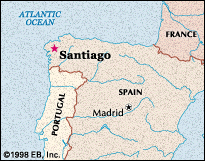
THE WORSHIP OF RELICS IN THE MIDDLE AGES
The pilgrim in the Middle Ages shared with the modern tourist a conviction that certain places and certain objects possess unusual spiritual power and that one was a better person for visiting them. Precisely how one came to be bettered may have been clearer to the mediaeval mind than it is to the traveller of the 20th century, since the benefits gained could then be attributed to the direct influence of God.
Places and objects acted, in effect, as divine go-betweens in a quest for personal salvation. They held out a link with an authority superior to man's, and by extension they came to be invested with magic powers of their own. It was well known that the surest way of getting God to listen was to go to them on a pilgrimage and ask.
It has been a characteristic of pilgrimages and of the tourist industry that both have attached themselves to surviving remnants of an earlier era.
The people of the Middle Ages had a passion for religious relics; we have a passion for historical relics-ruined temples, preserved cities, objects laid out in museums, bits of yesterday.
The Middle Ages themselves have become a part of our own store of relics. The 20th-century visitor to the Parthenon or Persepolis, through the kick he receives from being there, is attributing to these places a numinous and healing power.
This behaviour is not in essence different from the power that the mediaeval pilgrim attributed to the relics of the Roman martyrs or a fragment of the Holy Cross. We today, call that power Art, they a thousand years ago called it God.
In the mediaeval era the faith in relics was the product of a universal lack of faith in con-temporary life, and of a consequent expectation of the destruction to come. This lack of confidence in today, with its accompanying vision of Hell to-morrow, led to the search for an ideal only to be found in the imagined perfection of the past.
The only spiritual nourishment which made an absurd and nasty world bearable was to be obtained from the from ancient relics, these dry springs which proved that divine favor had once been received and was now withdrawn:
So the pilgrim journeyed in order to pay the prescribed respect out of duty, out of love, out of fear or out of a drive towards self improvement or superiority, but always as a means of averting the daily grind and of going on a journey. Travel became synonymous with an abdication into the past. It still is.
Why did they do it? Devotion, of course; but devotion to precisely what? Clearly the overwhelming majority of pilgrims to Santiago in the Middle Ages would never have undertaken so long and hazardous a journey far from home but for a spirit of genuine piety.
Equally clearly, their piety was a form of after life insurance against the promise of eternal damnation. This was preached relentlessly by a mediaeval church obsessed by the imminence of the Second Coming and the Day of judgement, and it was preached no less eloquently the sculptors and painters who decorated the churches in which those sermons were heard.
The simple illiterate man in the Middle Ages had no choice. From the day he learned to use his eyes and ears to the day he died he was indoctrinated with the urgency of obtaining divine forgiveness and the purification of his soul, and the surest means by which such a thing could be obtained was by contact with the saints, who could intercede on his behalf If the Saints were martyrs, so much the better; if they were martyred apostles. then better still.
Hence the morbid mediaeval cult of holy relics. Hence, too, the pre-eminence of the three pilgrimages in the Middle Ages. The one to Jerusalem. that to Rome. and the one to Santiago de Compostela and the tomb of St James the Apostle.
Santiago became the most popular object of pilgrimage of the three in the later Middle Ages, and engendered an intensity of devotion that was maintained over the entire period of the entrenchment and growth of Christianity and Christian art in Europe, from the 10th to the I 8th century.
Through out those centuries which saw the formation of Europe socially and culturally, this was the pilgrimage of Everyman; and because it enjoyed this role the route to Santiago became a principal high-road of Christian teaching, Christian institutions and Christian art. Perhaps there was an-other reason for the hold it had on the popular imagination. Santiago, far away under the mists and Atlantic skies of Galicia, all woods and water in a Celtic landscape ofmenhirs and lost gods, exerted an appeal that was infinitely pre Christian.
The route to Santiago was a Roman trade-route. It was nicknamed by travellers la voje ladee, the Milky Way. It was the road under the stars.
The pale arm of the Milky Way stretched out and pointed the way to the edge of the known world where the sun went down: to Cape Finisterre (from the Latin firns terra-the end of the earth). Historians who have studied the iconography of the pilgrim route have speculated on the meaning of the floral motif that recurs in mediaeval churches all along the way, as to whether it might in origin be, not a flower, but a sun image of Celtic origin from our dim past.
We know that for pilgrims reaching Santiago in the Middle Ages it was as obligatory to venture on to the chapel of Nuestra Senora at Finisterre, the last finger of land crooked into the ocean. One explanation for this is that, there may have been a earlier journey to heaven, more mystical and of far earlier provenance than the church could have expected to acknowledge. The myth then must go back to earlier times and that the first pilgrims may have travelled the camino to Cap Fimsterre even before the birth of Christ going as supplicants to some forgotten god.
The legend behind the cult of St James
THE BODY OF CHRIST'S DISCIPLE IN A FIELD OF STARS
After the death of Christ the disciples dispersed to different parts of the then known world, to spread the Gospel as they had been bidden. Saint James went to Spain, we are told, where he spent a couple of years evangelising, though apparently without a great deal of success. He then returned to Jerusalem but was beheaded by Herod shortly afterwards, in AD 44. Immediately following his martyrdom, however, his followers are said to have taken his body to Jaffa, on the coast, where a ship was miraculously waiting for them and they set off back to Spain.
They landed in Iria flavia on the coast of Galicia, some twenty kilometers from what is now Santiago de Compostela, after a Journey which is purported to have taken only a week, thereby providing proof of angelic assistance. Saint James's body was then buried in a tomb on a hillside, along and forgotten for the next 750 years. The story is considerably more complicated than this but these are the bare bones.
Early in the ninth century Pelagius, a hermit living in that part of Spain, had a vision (which he subsequently reported to Theodomir, bishop of Ira Flavia) in which he saw a very large bright star, surrounded by a ring of smaller ones, shining over a deserted spot in the hills. The matter was investigated and a tomb found there containing three bodies.
They were immediately identified as those of Saint James and two of his followers and when Alfonso II, King of the Asturias (791-824), went there he declared Saint James the patron saint of Spain. He built a church and a small monastery over the tomb in the saints honor, around which a town grew up. It was known as campus de Ia stella or campus steliae later shortened to compostela. This is one explanation of the origin of the name. Another is that it derives from the Latin componere (to bury), as
a Roman cemetery or early Christian necropolis is known to have existed under the site of the present day cathedral in Santiago - and where the remains of Saint James are still believed to be housed today.
News of the discovery soon spread. It was encouraged to do so, moreover, both by Archbishop Gelmirez and the cathedral authorities, who were anxious to promote the town as a pilgrimage centre, thus attracting money to the area, and by the monks of Cluny, who saw in it the opportunity to assist the Spanish church in their long struggle against the Moors. Both factions were also helped by the fact that the Turks had seized the Holy Sepulchre in 1078, thus putting a stop to pilgrimages to Jerusalem.
The modern day pilgrim
NEED A CHANGE? GET THOSE BOOTS ON -
The vast majority of those who walk The Way of St James are not experienced walkers at all. Many have never done any serious walking in their lives and many will never do serious walking again, for here, as in the past, walking is a means of transport, a means to an end, rather than an activity for its own sake.
Most long-distance footpaths also avoid not only large towns but even quite small villages as well; the Way of Saint James, on the other hand, because of its historic origins and the need for shelter, deliberately seeks them out.
Pilgrims have been travelling to Santiago de Compostela on foot or horseback for over a thousand years. (The Bishop of Le Puy, who went there in AD 950, was one of the first). Some say the cult of the spiritual traveller along the path existed even earlier as the way led to Cape Finisterre the end of the known world.
Its 800 kilometers from the Saint Jean Pied de Port in the foothills of the Pyrenees to Santiago de Compostela in the western reaches of Galicia have changed little in that time. For although sections of it have now become modern tarred roads and many of the "hospitals" and other accommodation set-up by religious orders along the way to minister to the needs of pilgrims have long since disappeared, the camino , as it is known in Spain, still passes through the same villages, crosses the same rivers, visits the same chapels, churches, cathedrals and other monuments as did the path taken by our predecessors in centuries gone by.
At the height of its popularity in the eleventh and twelfth centuries over half a million people a year are said to have made the pilgrimage from different parts of Europe, the majority of them from France.
The high point of the pilgrimage occurred between the years 1000 and l500 but although numbers dwindled after that, due to the Reformation and other, political, factors, the stream of pilgrims making the trudge westwards to the far reaches of Galiciain north-west Spain never completely dried up and in the late twentieth century is making something of a comeback.
Several thousand people walk the Way every year, whether from the Pyrenees, from different parts of France or from even further afield: it is not uncommon, even nowadays, to meet Swiss, German, Belgian or Dutch pilgrims, for example, who have set out from home to make the entire journey on foot. Most parts of the walker's route are also accessible to those riding mountain (though not touring) bikes.
The Cathedral authorities in Santiago maintain a register of pilgrims and in 1991 recorded a total of 7274 travelling on foot, bicycle or horseback (compared with 5760 in 1989, the year of the Pope's August visit there, and 4918 in 1990). The Way of Saint
The walk takes about a month and there are a number of refuges set up to accommodate the genuine pilgrim not the tourist. Some of these are in old monasteries, inns and seminaries others are provided by the villages along the way. Some are in grand establishments like the old Augustine abbey of Roncesvalles in the Pyrenees or the 12 centaury seminary at Puerto Reina
By the way if you do complete the walk all the way and can provide proof, you are entitled to three free meals for three days! at the magnificent Hotel de los Reyes at Santiago apply to the cathedral authorities.